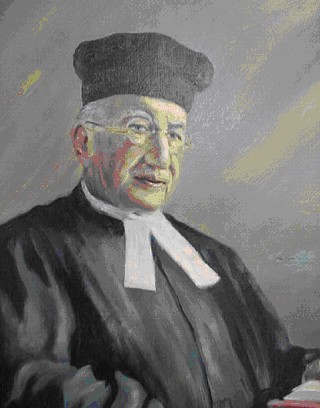|
| ||||
|
|
||||
|
The Establishment of Golders Green Synagogue by Lynne Fertleman 1916 In 1916, the Community sought to be affiliated to the Union of Hebrew and Religion Classes. Religion Classes had already started but, in February 1916, (16) there was correspondence between George Cohen and F Spiers, who was the Hon. Secretary of the Union of Hebrew and Religion Classes, to find out if the Committee had made a decision as to whether Golders Green could join their Union. On 7th December 1916, Mr F.S. Spiers, the Hon. Secretary of the Union of Hebrew and Religion Classes wrote to Mr Drage to advise that the Golders Green Classes had been granted constituents of the Union.
In July, the Synagogue appointed Mr Sydney Ellis as a temporary Reader and Teacher at a salary of £1 per week,(17) this position was made permanent in November when he became Assistant Reader and Teacher at a salary of £40 per annum.(18) However, Mr Ellis found it increasingly difficult to make a living and, in August 1918, he resigned to take up the appointment of Minister, Reader and Teacher of the Watford Hebrew Congregation.(19)
In August 1916 the Rev Isaac Livingstone was elected Minister of Golders Green Synagogue.(20) For some of the Jews who moved to the suburbs, the East End was something to forget.(21) In the early years the minister of an individual synagogue did not hold the title of Rabbi,(22) this honour was held by the Chief Rabbi. (23) The Synagogue also wanted to become a member of the United Synagogue(24) and a letter was addressed to Leopold De Rothschild in September 1916 to advise him that they intended to apply for membership.(25) The founder members of the United Synagogue were prominent members of Anglo-Jewry and followed the traditions of English upper-class society.(26) The board members of the individual synagogues, which included Golders Green, also followed this tradition and would wear morning dress and top hats.
(Original in Synagogue Archive Room) © United Synagogue
Mr Drage and the rest of the Committee started to look for possible permanent sites for the Synagogue. The criteria for the new building were that it had to be suitable for 400 male and 300 female worshippers. There also had to be space available for schoolrooms for 80-100 children. (27) A local builder and contractor, Mr Arthur J Reynolds, suggested various plots.
In June 1916 there was a possible plot of land on the corner of Templars Avenue and Finchley Road and consultations as to its viability was discussed with a firm of architects and surveyors, Messrs Lewis Solomon & Son. (28) However, the United Synagogue did not find this site acceptable.(29)
_________________________ References (which also appear if you hold the cursor over the number of the note in the text): (16) Letter dated 28.2.1916 addressed to F Spiers from G.Cohen. ‘Correspondence R-Z 1916-19’. (17) Letter 4.7.1916 from Mr Drage to Mr Ellis ‘Box 1-3, 1916-18’ folder ‘Correspondence 1916-19 A-E’ (Syn Archives). (18) Letters dated 24.11.1916 addressed to Mr Ellis (sender unknown) ‘Correspondence 1916-19 A-E’ (19) Letters dated 20.8.and 26.8.1918 from Mr Ellis to Rev Livingstone ‘Correspondence 1916-19 A-E’ (20) Jewish Year Book 1917 (London: Jewish Chronicle, 1917) pp.267. (21) Jewish Chronicle – 28th Sept 1979. pp.28. (22) There was a gradual change in the 1960’s after Sir Isaac Wolfson became President of the United Synagogue in 1962. The leadership became more observant and the Rabbi’s were no longer addressed as Reverend. [Brook, Stephen The Club – The Jews of Modern Britain (London. Pan Books Ltd, 1990) pp.93]. (23) Newman, Aubrey The United Synagogue 1870-1970 (London: Routledge, 1977) pp.87-88. (24) A Private Act of Parliament created the United Synagogue in 1870. It basically embodied mainstream Judaism and its members had to be Jewish. It unified congregations of German and Polish decent who had to accept the Ashkenazi religious rituals. [Lipman, V.D. pp.26]. (25) Unsigned letter dated 2.9.1916 addressed to Leopold De Rothschild. ‘Correspondence R-Z ‘. (26) Newman. pp46-49. (27) Letter dated 6.6.1915 from Lewis Solomons & Son to Mr Drage. Box marked ‘Box 1 1916-23’ folder ‘Building 6-7, Solomons & Son Architects’. (28) Letter dated 6.6.1916 from Lewis Solomons & Son to B. Drage. ‘Building 6-7’. (29) Letter dated 5.3.1917 from B. Drage to Lewis Solomons & Son. ‘Building 6-7’.
|
|
About JCR-UK | JCR-UK home page | Contact JCR-UK Webmaster
This website is
owned by JewishGen and the Jewish Genealogical Society of Great Britain. All
material found herein is owned by or licensed to us. You may view, download, and
print material from this site only for your own personal use. You may not post
material from this site on another website without our consent. You may not
transmit or distribute material from this website to others. You may not use
this website or information found at this site for any commercial purpose. Copyright © 2002 - 2024 JCR-UK. All Rights Reserved |



